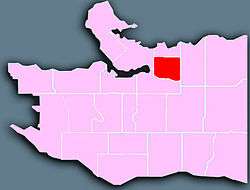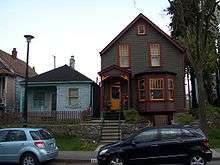Strathcona, Vancouver
| Strathcona | |
|---|---|
| Neighbourhood | |
 Streetmap | |
 Location within the city of Vancouver | |
| Coordinates: 49°16′45″N 123°5′15″W / 49.27917°N 123.08750°WCoordinates: 49°16′45″N 123°5′15″W / 49.27917°N 123.08750°W | |
| Regional district | Metro Vancouver |
| City | Vancouver |
| Neighbourhood | Downtown Eastside |
| Named for | Donald Smith, 1st Baron Strathcona and Mount Royal |
| Government | |
| • MP |
NDP Jenny Kwan (Vancouver East) |
| • MLAs |
NDP Melanie Mark (Vancouver-Mount Pleasant) |
| Area[1][2][3] | |
| • Total | 3.00 km2 (1.16 sq mi) |
| Population (2006)[1][2][3] | |
| • Total | 11,823 |
| • Density | 3,900/km2 (10,000/sq mi) |
| Visible minority[lower-alpha 1][1][2][3] | |
| • Chinese | 43% |
| • Other | 12% |
| Time zone | PST (UTC−8) |
| • Summer (DST) | PDT (UTC−7) |
| Postal code | V6A |
| Area code(s) | 604, 778 |
| Median income | C$12,495–13,677 (2006)[4] |
| Website |
strathcona-residents strathconabia |
| |



Strathcona is Vancouver, British Columbia's oldest residential neighbourhood. It is bordered by Chinatown to the west, Clark Drive to the east, and Canadian National Railway and Great Northern Railway (now BNSF Railway) classification yards to the south. By some definitions, its northern border is the roads just south of Burrard Inlet, and much of the Downtown Eastside lies within Strathcona.[7] By other definitions, Strathcona's northern boundary is just south of Hastings Street, and the Downtown Eastside is a separate neighbourhood to the north and northwest of Strathcona [7]
History
Over 11,800 people live in Strathcona,[1] [2] [3] which grew during the city's boom years between the city's founding in 1886 and 1920 due in large part to the choice of early Vancouver as a railway terminus. It emerged from the original settlement that grew around Hastings Mill. Originally called the East End, the neighbourhood adopted the name Strathcona in the 1960s. It has always been a working-class neighborhood, and its residents have always been from many ethnic backgrounds. It is the only neighbourhood where English is not the most commonly spoken language, with 61% of residents reporting Chinese as their mother tongue, followed by English at 24%.[8]
The neighbourhood was earmarked for demolition in the 1950s as part of an urban renewal program. Strathcona would have been transformed into "block upon block of identical apartments buildings and townhouses" for social housing. The redevelopment plans proceeded with the construction of the McLean Park housing development between Union, Keefer, Gore and Jackson, and Stamp's Place on Campbell between Hastings, Union and Raymur some 15 blocks of the neighbourhood were bulldozed including Hogan's Alley, the only area with a concentration of blacks in Vancouver.[9] Development was stopped due to opposition from the community, led by residents such as Bessie Lee and later joined by♙Mary Lee Chan who banded together to form the Strathcona Property Owners and Tenants Association (SPOTA). Important municipal figures such as mayor Mike Harcourt and the TEAM and later COPE party emerged from this movement.
Just as the neighbourhood organisers were making headway at preserving the neighbourhood, city engineers proposed putting a freeway through the southern part of the neighbourhood which would have connected to a proposed waterfront route. The connectors along Gore and Carrall Streets, would have partially destroyed Chinatown and Gastown.
The Mau Dan Gardens Co-operative was established in October 1981, the last of five projects initiated by the Strathcona Area Housing Society (SAHS) to provide housing for the residents of the Strathcona area whose homes were expropriated and demolished in the urban renewal clearance scheme of 1965.
In 1972, after protest by the local community, the city abandoned its plan to build a municipal fire hall on the vacant site and reserved the property known as site “C & D” for family housing. The land, owned by the City of Vancouver, is now leased to the Mau Dan Gardens Co-operative Housing Association.
The founding membership of the Co-operative was predominantly of Chinese ethnicity, but included families of Vietnamese, Cambodian, Japanese and Canadian origin.[10]
In recent years, Strathcona has been subjected to a significant gentrification process, reinforcing the economic disparity of the area. The late 19th and early 20th century architecture in the area is a relative rarity in Vancouver and many houses in Strathcona are designated heritage houses. This housing stock in particular is being renovated, thus raising property values and attracting wealthier home owners to the area. A number of homeowners have restored their houses in the original Victorian or Edwardian styles, with a particular attention to the "true colours" of the period,[5] which in some cases has been supported by grants from the "Restore It!" program of "Restore It!" Program Vancouver Heritage Foundation
Education
There are two public elementary schools located within Strathcona: Lord Strathcona and Admiral Seymour. Also named for Donald Smith, 1st Baron Strathcona and Mount Royal, Lord Strathcona Elementary was founded in 1891 and is the oldest school in Vancouver. The school is attached to a community centre and the school library doubles as a branch of the Vancouver Public Library. Admiral Seymour Elementary was named in honour of Sir Edward Hobart Seymour, a former Admiral of the fleet of the Royal Navy. Strathcona is in the secondary school catchment area of Britannia Secondary School.
There is also an independent school, Avenir School. Avenir is for gifted children and educates in grades 6 to 12. It was founded by the Avenir School Society, a non-profit organization.[11][12]
Vancouver Japanese Language School is also located in Strathcona. Established in 1906 as Vancouver Japanese Citizens School (晩香坡共立日本國民學校 Vancouver Kyōritsu Nihon Kokumin Gakkō), it is the oldest Japanese school in Canada.[13] Although properties owned by the Japanese Canadians were forfeited by the government during the World War II and were never returned, school building on Alexander St is the only property in Canada where the half of ownership was returned to the Japanese Canadian community after the internment.[14] Vancouver Japanese Language School is offering Japanese immersion preschool as well as various Japanese language courses.
Demographics
As of 2006, Strathcona has 11,920 people, a 3% increase from 2001. 13.5% of the population is under the age of 19; 23.5% is between 20 and 39; 38.9% is between 40 and 64; and 24.0% is 65 or older. 43.9% of Strathcona residents speak English as a first language, and 40.3% speak a Chinese language. The median household income is $15,558, and 59.4% of its population lives in low-income households. Its unemployment rate is 11.1%.
See also
| Wikimedia Commons has media related to Strathcona, Vancouver. |
References
- 1 2 3 4 "Census tract profile for 0057.01 (CT), Vancouver (CMA) and British Columbia". Statistics Canada. June 1, 2010. Retrieved November 21, 2013.
- 1 2 3 4 "Census tract profile for 0057.02 (CT), Vancouver (CMA) and British Columbia". Statistics Canada. June 1, 2010. Retrieved November 21, 2013.
- 1 2 3 4 "Census tract profile for 0058.00 (CT), Vancouver (CMA) and British Columbia". Statistics Canada. June 1, 2010. Retrieved November 21, 2013.
- ↑ Skelton, Chad (March 1, 2012). "Rosemary Heights in Surrey is richest place in Metro Vancouver". Vancouver Sun. Retrieved November 21, 2013.
- 1 2 "True Colours" Program (Vancouver Heritage Foundation)
- ↑ Kalman, Harold; Ward, Robin (1974). Cheung, Iva, ed. Exploring Vancouver: The Architectural Guide. Vancouver, BC: Douglas & McIntyre. ISBN 978-1-55365-866-5. Retrieved November 21, 2013.
- 1 2 "Strathcona North of Hastings". Heritage Vancouver. Retrieved 20 August 2016.
- ↑ , Vancouver Public Library, Strathcona Branch
- ↑ "Reviving Black Strathcona". Vancouver Foundation
- ↑
- ↑ "Avenir School". Avenir School. Retrieved 5 December 2013.
- ↑ "School Information - District 039 - Vancouver". British Columbia Government. Retrieved 5 December 2013.
- ↑ Asato, Noriko (2006). Teaching mikadoism : the attack on Japanese language schools in Hawaii, California, and Washington, 1919-1927. Honolulu: University of Hawaii Press. p. 15. ISBN 978-0-8248-2898-1.
- ↑ "487 Alexander Street - Vancouver Japanese Language School". Open Doors Project. Retrieved 3 May 2015.